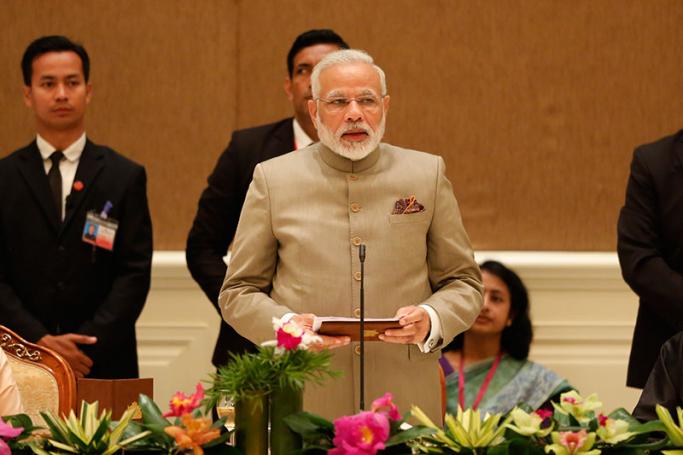India is looking to set its bilateral relations with Myanmar to a new high during the Prime Minister’s visit to the country from 5-7 September.
As Modi himself announced in his Twitter message, India prioritises the infrastructure projects, especially those related to connectivity.
"That holds the key to the success of India's Act East policy. Through Myanmar, India seeks to connect not only to other Southeast Asian countries but also to its own Northeast by using the Kaladan Multi-Modal project," says Jiten Nongthoubam, head of Myanmar Studies Centre at Manipur University.
Jiten says this is intricately linked to India's policy of using its long-troubled Northeast to pursue the Act East policy.
"So there is an unusual push we find in boosting connectivity and infrastructure in the Northeast and neighbouring countries like Myanmar. It is all, perhaps for the first time, part of a well-conceived policy," says Prabir De, lead researcher with Indian thinktank RIS.
However, Modi in his tweet also stresses cooperation in boosting security and in the fight against terrorism, making it clear India stands by Myanmar's efforts not merely to find durable peace through resolving its long-festering ethnic insurgencies but also in tackling the latest surge of Rohingya terrorism.
Indian military training teams are already working with Myanmar's Tatmadaw to prepare them for UN peace keeping duties that are seen as essential to redeem their global image.
The strong statement from Delhi supporting Myanmar's fight against terrorism and offering condolences over the death of its security personnel in the Aug 25 ARSA attacks, coming just before the Modi visit, has been interpreted as an effort to connect to both the civilian government in Nay Pyi Taw and the still-powerful Tatmadaw.
"The diplomatic exercise to engage both the Daw Suu Kyi government and the military is an important exercise, which, if successful, can be replicated in Pakistan," says National Professor Jayanta Ray, former head of the Maulana Azad Institute of Asian Studies.
ARSA is seen by India's intelligence establishment as part of a Pakistani LET-backed jihadi network in the East, alongside Bangladesh's JMB and Indian Mujahideen.
"So we have to get Myanmar and Bangladesh on board to fight these dangerous groups. That is why Modiji stresses cooperation in fighting terrorism," said an Indian intelligence official, who preferred not to be named.
China's silence on the Rakhine issue and its growing unpopularity over seekinga85% stake in the Kyaukphyu project has helped India act strongly to restrict the influence of its northern neighbour in Myanmar.
Indian Ambassdor Vikram Misri was subtly aiming at China when he said India funds and implements development projects but aims to develop them as Myanmar's public assets to be handed over to the government in Nay Pyi Taw.
"That is where our approach differs with some countries who seek to create their commercial assets in this country," Misri said, in an obvious oblique reference to China and the Kyaukphyu project and India's own Kaladan Multi Modal project, two phases of which have been completed.
India's Myanmar policy will now be determined by not only efforts to limit Chinese influence in this country and push its own Act East agenda to connect to the rest of Southeast Asia through Myanmar.
It will also be guided by a stronger engagement both with the civilian government and the military to not only curb terrorism but also the trafficking of narcotics produced in Myanmar's Golden Triangle and Chinese-made weapons through the cobweb of ethnic insurgents like the United Wa State Army.
Helping Myanmar institutionalise its democracy through greater parliamentary training for its lawmakers in India and professionalise its army through intensive training helps India address both important constituents in Myanmar.
By that, India will not only seek to neutralise the last trans-border base area (Bhutan and Bangladesh have already cracked down on them) of its northeastern rebels in Sagaing but also push its Act East agenda through the northeast by turning this into a zone of peace.
"India gains by a peaceful and economically strong Myanmar, not by meddling with its insurgents or by trying to extract its resources. We want to sell our electricity and our processed petroleum products to Myanmar, not take away power through controversial projects like Myitsone," says John Mukherjee of Indian thinktank CENERS.
" We want a strong and prosperous Myanmar at peace with neighbours and its ethnic minorities. It works for India because we cannot connect to other countries in Southeast Asia inspite of good roads and rail if Myanmar or our own Northeast remains disturbed," says Mukherjee, a former chief of staff of India's Eastern Army.
His final line is aimed at China -- "we want Myanmar as a friend and an ally, not as a vassal."
You are viewing the old site.
Please update your bookmark to https://eng.mizzima.com.
Mizzima Weekly Magazine Issue...
14 December 2023
Spring Revolution Daily News f...
13 December 2023
New UK Burma sanctions welcome...
13 December 2023
Spring Revolution Daily News f...
12 December 2023
Spring Revolution Daily News f...
11 December 2023
Spring Revolution Daily News f...
08 December 2023
Spring Revolution Daily News f...
07 December 2023
Diaspora journalists increasin...
07 December 2023
The Spring Revolution of Mizzima












